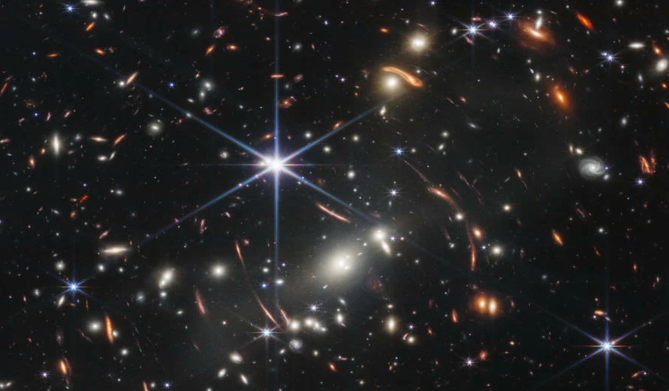Within the first picture NASA launched from the Webb telescope, some galaxies seem like strings of stretched taffy.
That is as a result of the universe itself has altered our view of the deep cosmos.
Astronomers not too long ago pointed the colossal James Webb House Telescope at a cluster of galaxies dubbed SMACS 0723. Crucially, galaxies are enormously huge objects as they include lots of of billions of stars, tens of millions of black holes, and maybe trillions of planets. The mixed mass of those galaxies warps area, like a bowling ball sitting on a mattress.
This warped area basically creates a “lens” that we glance by way of. So the sunshine from the galaxies behind this galactic cluster that we (or the Webb telescope) in the end see is distorted. It is an incidence known as “gravitational lensing.” Because the House Telescope Science Institute (which runs the telescope) explains: “It is like having a digicam lens in between us and the extra distant galaxies.”
Albert Einstein predicted the impact of gravitational lensing over a century in the past. A number of the galaxies we will view beneath in Webb’s first deep view into the cosmos, then, are magnified, and a few are profoundly stretched or distorted.
“They have been magnified by the gravity of the cluster, similar to Einstein stated they’d,” NASA astrophysicist Jane Rigby stated on the reveal of Webb’s first scientific photographs.

Within the picture above, the cluster of white-looking, ethereal galaxies are some 4.6 billion years outdated. They fashioned across the similar time because the solar and Earth, Rigby stated. It is these white galaxies that enlarge and alter the view behind.
These extra distant objects, which embrace each the pink dots and bizarrely-distorted galaxies, are among the many oldest objects within the cosmos. “All of the tremendous faint, dark-red tiny dots, in addition to lots of the brighter, unusually formed objects on this astounding picture are extraordinarily distant galaxies that no human eye has seen earlier than,” Harald Ebeling, an astronomer on the College of Hawaii Institute for astronomy, stated in an announcement.
The faintest objects on this Webb picture are some 13.1 billion years outdated, Rigby stated. But Webb will quickly look even farther into the previous, over 13.5 billion years in the past, quickly after the primary stars and galaxies fashioned.
The deep area observatory
The Webb telescope — a collaboration between NASA, the European House Company, and the Canadian House Company — is designed to make unprecedented discoveries. “With this telescope, it is actually onerous to not break information,” Thomas Zurbuchen, an astrophysicist and NASA’s affiliate administrator for the company’s Science Mission Directorate, not too long ago stated at a press convention.
Here is how Webb will obtain unparalleled issues:
- Big mirror: Webb’s mirror, which captures gentle, is over 21 ft throughout. That is over two and a half occasions bigger than the Hubble House Telescope’s mirror. Capturing extra gentle permits Webb to see extra distant, historical objects.
“We will see the very first stars and galaxies that ever fashioned,” Jean Creighton, an astronomer and the director of the Manfred Olson Planetarium on the College of Wisconsin–Milwaukee, informed Mashable final 12 months.
- Infrared view: In contrast to Hubble, which largely views gentle that is seen to us, Webb is primarily an infrared telescope, that means it views gentle within the infrared spectrum. This permits us to see way more of the universe. Infrared has longer wavelengths than seen gentle, so the sunshine waves extra effectively slip by way of cosmic clouds; the sunshine would not as typically collide with and get scattered by these densely-packed particles. In the end, Webb’s infrared eyesight can penetrate locations Hubble cannot.
“It lifts the veil,” stated Creighton.
- Peering into distant exoplanets: The Webb telescope carries specialised gear, known as spectrometers, that may revolutionize our understanding of those far-off worlds. The devices can decipher what molecules (akin to water, carbon dioxide, and methane) exist within the atmospheres of distant exoplanets — be it gasoline giants or smaller rocky worlds. Webb will have a look at exoplanets within the Milky Manner galaxy. Who is aware of what we’ll discover.
“We would study issues we by no means considered,” Mercedes López-Morales, an exoplanet researcher and astrophysicist on the Heart for Astrophysics-Harvard & Smithsonian, informed Mashable in 2021.
